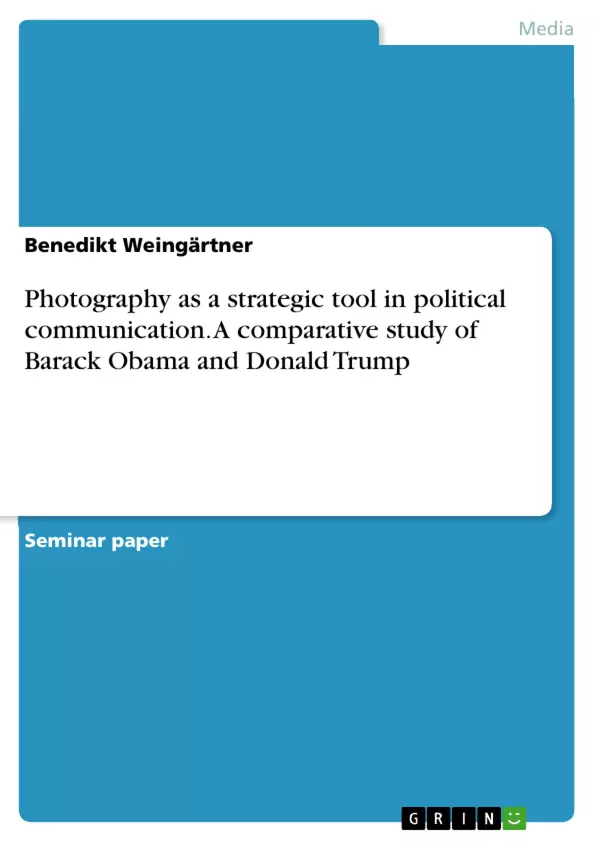For both, Obama and Trump, the political communication via official photographs serves the purpose to convey and reinforce their political core messages. Still, both take a very different approach since they also have very different key messages to send out. In the case of Donald Trump the official photographs can be considered as to be set in a broader political "communicative context" to underline his core message of him being the central figure to solve America’s problems.
For Obama, this applies in particular to his unifying and optimistic message ("Yes we can") of the United States of America as well as to his image as a young, agile President from a new generation of politicians.
Table of Contents
- Political Communication and Imagery
- Barack Obama's and Donald Trump's political communication and core messages
- How does the official picture language of the Obama and Trump serve as a strategic tool to emphasise their political messages?
Objectives and Key Themes
This paper aims to analyze how photography is used as a strategic tool in the political communication of Barack Obama and Donald Trump. It compares their distinct communication styles and examines how official White House photography reinforces their core political messages.
- Political communication through imagery
- Comparative analysis of Obama and Trump's communication strategies
- The role of photography in shaping public perception
- The use of visual narratives in presidential communication
- The impact of social media on political image-making
Chapter Summaries
Political Communication and Imagery: This chapter introduces the concept of political communication, highlighting its interactive nature and the increasing importance of imagery, particularly photography, in shaping public opinion. It emphasizes how photographs, despite their potential for diverse interpretations, can effectively transmit emotional and holistic messages, surpassing the impact of lengthy speeches. The chapter sets the stage for the comparative analysis of Obama and Trump's use of photography in their political communication.
Barack Obama's and Donald Trump's political communication and core messages: This section delves into the distinct communication styles of Obama and Trump. Obama's approach is characterized as optimistic, inclusive, unifying, and factual, while also incorporating emotional appeals. His communication emphasizes pluralism, multiculturalism, and diversity, conveying a message of hope, change, and optimism, as exemplified by his campaign slogan "Yes, we can." In contrast, Trump's communication is described as emotional, divisive, and pessimistic, highlighting perceived flaws and shortcomings within the United States. His strategy centers on addressing security concerns (internal and external) and economic issues, proposing solutions and positioning himself as the agent of change capable of "fixing" America's problems. This chapter highlights the contrasting narratives used by both presidents to connect with their electorates.
Keywords
Political communication, imagery, photography, Barack Obama, Donald Trump, visual narrative, social media, public perception, communication strategy, core message, presidential communication.
Frequently Asked Questions: Analysis of Obama and Trump's Political Communication Through Imagery
What is the main topic of this document?
This document provides a comprehensive preview of an academic paper analyzing the political communication strategies of Barack Obama and Donald Trump, focusing on how they utilize imagery, specifically photography, to convey their core messages and shape public perception.
What are the key themes explored in the paper?
The paper explores political communication through imagery, comparing and contrasting Obama and Trump's communication styles. It examines the role of photography in shaping public perception, the use of visual narratives in presidential communication, and the impact of social media on political image-making.
How does the paper compare Obama and Trump's communication styles?
The paper contrasts Obama's optimistic, inclusive, and unifying communication style, emphasizing pluralism and hope, with Trump's more emotional, divisive, and pessimistic approach, focused on security and economic concerns. It highlights how their contrasting narratives were used to connect with their respective electorates.
What is the role of photography in the paper's analysis?
Photography serves as a central element of the analysis, demonstrating how it's used as a strategic tool to reinforce each president's core political messages. The paper examines how seemingly simple photographs can effectively transmit complex emotional and holistic messages, often more powerfully than lengthy speeches.
What are the key objectives of the paper?
The paper aims to analyze how photography is used strategically in the political communication of both presidents. It seeks to compare their distinct communication styles and examine how official White House photography reinforces their core political messages and shapes public perception.
What are the chapter summaries provided in the preview?
The preview includes summaries of chapters covering the introduction to political communication and imagery, a detailed comparison of Obama and Trump's communication styles and core messages, and the overall impact of their use of imagery.
What are the keywords associated with this paper?
Keywords include: Political communication, imagery, photography, Barack Obama, Donald Trump, visual narrative, social media, public perception, communication strategy, core message, presidential communication.
What type of audience is this document intended for?
This document preview is intended for an academic audience, providing a structured and professional overview suitable for research and analysis purposes. The language and format are appropriate for scholarly discussion.
- Quote paper
- Benedikt Weingärtner (Author), 2017, Photography as a strategic tool in political communication. A comparative study of Barack Obama and Donald Trump, Munich, GRIN Verlag, https://www.grin.com/document/370776



